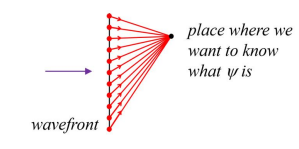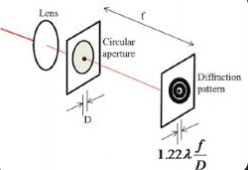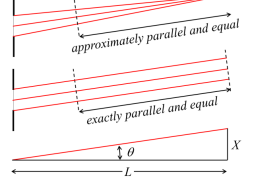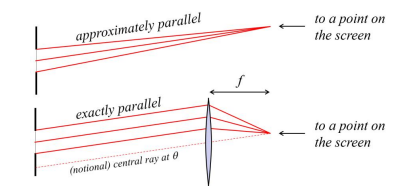Wave optics: Diffraction 3
1/21
Earn XP
Description and Tags
sem1 /2
Name | Mastery | Learn | Test | Matching | Spaced |
|---|
No study sessions yet.
22 Terms
What is the Huygens-Fresnel principle?
Every point on a wavefront serves as a source of secondary wavelets. The disturbance at a point beyond is the superposition of all these wavelets.
According to Huygens' Principle, how does a wavefront produce diffraction when passing through a slit?
The wavefront acts as a continuous sheet of point sources, where disturbances ("wavelets") from these sources interfere with each other ("superposition"), causing diffraction.

What is an aperture?
An aperture is a hole in an otherwise-opaque barrier that allows light to pass through.

Can an aperture refer to something other than a hole in a barrier?
Yes, an aperture can also refer to any localized pattern of light that propagates into free space.
What is the aperture function a(x,y)?
It’s the wave function just after the aperture
It describes how the incident wave function ψ times the aperture's transmission coefficient t varies across the aperture.
What is a 1-D slit, and how does its aperture function a(x,y) behave?
Its a narrow gap of width h along x that theoretically extends to ±∞ along y
This makes the aperture function a(x,y) independent of y.

What is the aperture function for a 1-D slit of width h?
Its a(x)=1 for ∣x∣≤h/2 and a(x)=0 for ∣x∣>h/2
How is the light illuminating the slit modelled in Fraunhofer diffraction for a 1-D aperture?
The slit is illuminated by a plane wave traveling in the z-direction, with constant amplitude and phase across the aperture.
What is the goal of Fraunhofer diffraction analysis for a 1-D slit?
Its to calculate the light intensity pattern observed on a projection screen far from the aperture.
What assumption is made about the light rays leaving the aperture in Fraunhofer diffraction?
The rays leaving the aperture are assumed to be approximately parallel due to the large distance between the aperture and the projection screen.
What is the Fraunhofer diffraction equation?
ψ(θ)= The total wave function at the point X on the screen
a(x)= the aperture function at each point x
eikx = the complex exponential representing the wave propagation from the point x in the aperture towards the screen.
k=2π/λ

What is Fraunhofer diffraction?
its the diffraction pattern observed when light passes through an aperture, and the screen is far enough away that the rays to any point on the screen are approximately parallel.

When does Fraunhofer diffraction occur?
When the source of light and the screen are both at infinite distances
When the rays traveling from the aperture to the screen are approximately parallel.
What condition is assumed for Fraunhofer diffraction in terms of light rays?
The light rays are assumed to be parallel as they travel from the aperture to the screen.
What is the condition for Fraunhofer diffraction to apply?
It applies when the scale of the diffraction pattern (lobe width H) is large compared to the geometrical shadow of the slit (slit width h).
What is the condition for Fraunhofer diffraction?

What is the far field in diffraction?
Its the region where the distance L to the screen is large enough that the diffraction pattern follows Fraunhofer diffraction, and the derivation of the intensity function I(q) is reliable.
What is the near field in diffraction?
Its the region where the distance to the screen is small, and the diffraction pattern closely resembles the geometrical shadow of the slit.
What is the Fresnel zone in diffraction?
The region between the near field and far field, where the diffraction pattern is transitioning from the near field to the far field
What is the diffraction pattern in the Fresnel zone called?
Fresnel diffraction
How can you obtain a true Fraunhofer diffraction pattern without a long distance L?
By using a positive lens → it focuses parallel rays onto a single point in the focal plane.

Where does the Fraunhofer diffraction pattern appear?
At the focal plane of a lens.